Archived Fire Damage Blog Posts
5 Fire Prevention Tips For Port Charlotte Florida Homeowners
8/23/2022 (Permalink)
 After the fire department leaves, call SERVPRO of Port Charlotte to help restore your home or business.
After the fire department leaves, call SERVPRO of Port Charlotte to help restore your home or business.
A fire can be one of the most traumatic events in one's life. But the trauma and damage can be lessened if your home and everyone living there is aware of the basic steps of fire preparation. By being prepared in case of a fire, you provide insurance to help keep yourself and your family safe. Here are five tips to help survive a fire.
- Test all smoke alarms and carbon monoxide detectors in your home. It is great that your home has smoke alarms and carbon monoxide detectors. But you need to test them regularly (at least every 3 months) to ensure that they are working how they are intended too.
- Leave them sprinklers systems alone! Many newer multifamily home buildings (condos and townhomes) come with sprinkler systems built into the ceilings and walkways. NEVER hang anything from a sprinkler or block its path or tamper with them. You could create a water damage and/or reduce the effectiveness of the sprinkler system.
- Purchase a fire extinguisher: A multi-class fire extinguisher can help prevent a small fire from becoming a whole home disaster. Strategically place them in areas where a fire may happen (kitchen, outdoor bbq area, laundry, garage, utility room, workshop, etc.) and near exit points. A fire extinguisher should only be used when a fire is confined to a small space. Do not try to fight a large fire with an extinguisher.
- Stay alert while cooking. Kitchen fires are often the cause of a residential fire. A grease fire is one of the most common types of kitchen fires. Please remember do NOT use any kind of liquid to extinguish a grease fire. Pouring a liquid of will just spread the grease and potentially cause more damage or injury. if possible and safe to do so, turn off the heat, cover the fire with a baking sheet or large pan to remove the oxygen supply. A class B, BC, or ABC fire extinguisher can be used as a last resort as it will contaminate your kitchen, but better than a full fire. If you are unsure and do not feel you have the ability to handle the fire, evacuate yourself and anyone else in the home and call 911.
- Have an evacuation and ready plan. Prepare a plan and practice your plan with all home residents. Have a clear plan to know how to evacuate your home in case of a fire or other disaster and also a safe spot where to meet at afterwards.
Despite how prepared we are there are potential events that result in fires that are uncontrollable and that cause widespread damage to a property. That is where SERVPRO of Port Charlotte steps in to help. Fire cleanup should be left up to a professional restoration company that can aid in minimizing the fire damage as much as possible.
If you need any help with residential or commercial fire damage and clean up, please call us 24/7 365 days a year: SERVPRO of Port Charlotte, 941-629-0966
Charlotte County Wildfire Preparation Tips
11/19/2021 (Permalink)
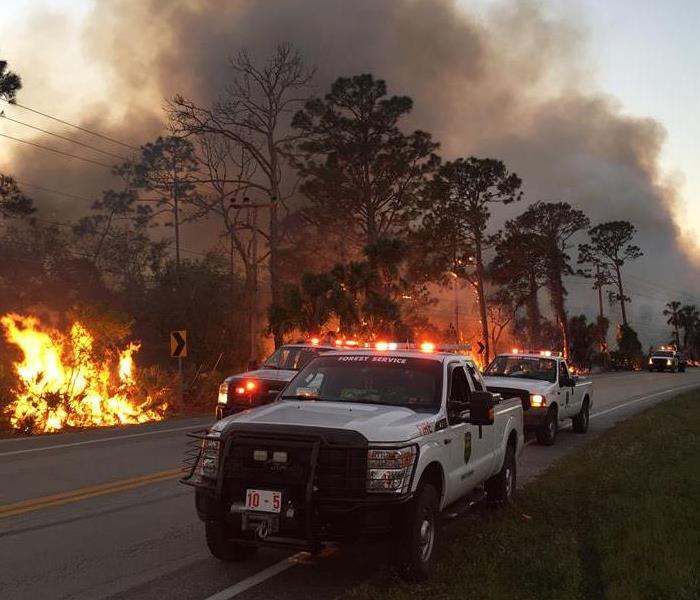 Be Prepared for a Wildfire in Florida
Be Prepared for a Wildfire in Florida
Wildfires! When most folks think of wildfires, they envision the massive fires that often rage in the western parts of the United States western states of California, Oregon, Washington, Nevada, Idaho, or in Central and South American rain forests, or Australia. While Florida is fortunate to have a rainy season, the dry season in Southwest Florida can create very arid conditions, and because our vegetation and timber are loaded with 'fuel', wildfires in Florida burn fast and hot. The 200+ acre wildfire in Placida and Rotunda West (February 2020) serves as a strong reminder of how close homes here in Charlotte County can be affected by a fast moving wildfire.
Following are some tips from the National Fire Protection Agency on how to best prepare before, during, and after a wildfire threatens our community.
Before a wildfire threatens your area…
In and around your home
- Clear leaves and other debris from gutters, eaves, porches and decks. This prevents embers from igniting your home.
- Remove dead vegetation and other items from under your deck or porch, and within 10 feet of the house. Learn more about the basics of defensible space on the Firewise website.
- Screen or box-in areas below patios and decks with wire mesh to prevent debris and combustible materials from accumulating.
- Remove flammable materials (firewood stacks, propane tanks) within 30 feet of your home’s foundation and outbuildings, including garages and sheds. If it can catch fire, don’t let it touch your house, deck or porch.
- Wildfire can spread to tree tops. Prune trees so the lowest branches are 6 to 10 feet from the ground.
- Keep your lawn hydrated and maintained. If it is brown, cut it down to reduce fire intensity. Dry grass and shrubs are fuel for wildfire.
- Don’t let debris and lawn cuttings linger. Dispose of these items quickly to reduce fuel for fire.
- Inspect shingles or roof tiles. Replace or repair those that are loose or missing to prevent ember penetration.
- Cover exterior attic vents with metal wire mesh no larger than 1/8 inch to prevent sparks from entering the home.
- Enclose under-eave and soffit vents or screens with metal mesh to prevent ember entry.
- Learn more about how to protect your home and property at www.firewise.org.
Creating an emergency plan
- Assemble an emergency supply kit and place it in a safe spot. Remember to include important documents, medications and personal identification.
- Develop an emergency evacuation plan and practice it with everyone in your home.
- Plan two ways out of your neighborhood and designate a meeting place.
- Learn more about emergency preparedness planning on NFPA’s emergency planning webpage.
In your community:
Read more at the following link: Wildfire preparedness tips
6 Fire Safety Tips For Every Home
7/26/2021 (Permalink)
 Be Prepared and Have a Home Fire Escape Plan
Be Prepared and Have a Home Fire Escape Plan
Our homes are our sanctuaries, and unfortunately they can also be a source for multiple opportunities for fire danger: not attending a stovetop can result in a kitchen fire; electrical systems can become defective; appliances can overheat; open flames from fireplaces, candles, flammable liquids, and outdoor grills — to name just a few — all add to the risk of a fire in our home.
Having the correct fire safety equipment and escape plan for your home is essential to keep your family safe and your house protected. We are happy to share with you the following six fire safety tips to help better prepare your home and loved ones in case there is a fire. The peace of mind that comes from knowing you’re prepared is worth the time, effort, and expense involved.
Fire Escape Plan
While not a 'piece of equipment' the most important thing you can have is a plan. Make sure anyone living in your home knows what to do and understands how to escape if there is a fire. Smoke and heat from a fire can lead to confusion and panic. The best way to combat this uncertainty is to have a plan that is easy to remember and provides for safe exists for everyone. If you need help preparing your plan, here is a good resource from the American Red Cross: Home Fire Escape Plan or this one from the NFPA: Escape Planning Tips
Smoke Alarms
This is your first line of defense. According to the American Red Cross, the National Fire Alarm Code (NFPA 72) requires all new homes to have inter-connected hard-wired smoke alarms with battery backup. If you don’t have an interconnected system, battery-powered alarms are easily installed. Both types of alarms need to be located on every level of the home with one inside each bedroom.
Fire Extinguishers
Since most home fires start in the kitchen, you’ll want to put a fire extinguisher in there, at a minimum. But it’s recommended to place them in multiple locations around the house. Since extinguishers from various makers all work differently, it’s a good idea for the adults in the household to get training from the local fire department. Extinguishers should be installed near exits, away from heat sources, and up high enough that kids can’t reach them.
Sprinkler Systems
While a smoke alarm will detect smoke, an automatic sprinkler system gives you a way of dealing with flames immediately. While you’re waiting on the fire department to arrive, sprinklers can help slow a fire’s progress or can even douse it completely. Moreover, a sprinkler system can prevent deadly gases and smoke from affecting your family and could also extinguish a fire that breaks out while you’re away from home.
Carbon Monoxide Alarms
There’s a good reason carbon monoxide (CO) is called the “silent killer.” This deadly gas is invisible, odorless, and colorless and even a small amount can be fatal if inhaled for long enough. Install carbon monoxide alarms on each level of your home and outside bedrooms. If the alarm emits its high-pitched warning, get outside as quickly as possible or open windows and doors and take deep breaths of fresh air. CO poisoning can cause headaches, nausea, and tiredness and can be mistaken for flu.
Fire Escape Ladders
If your home has more than one floor, collapsible fire ladders should be a part of your fire-safety arsenal. Place a ladder where it’s easy to access in every upper-level room in case your evacuation route gets cut off by smoke or fire. Then, have the entire family rehearse the steps they would take to get the ladders out and attached to open windows. As noted in the following link on Ready.gov, make sure to practice to ensure everyone can safely use the ladder: Home Fire Escape Plan
No one wants to dwell on the possibility of their family being in danger or their home being consumed by flames, but this is one situation where being properly prepared could save lives and property. If you haven’t already done so, make an escape plan and go over it with your family. And check your homeowner’s insurance to make sure your policy is up to date with adequate coverage.
If you have any questions, give us a call and also ask about our Emergency Ready Profile, to help you be prepared for all disaster, manmade and natural.
BBQ and Outdoor Fire Safety Tips
6/29/2021 (Permalink)
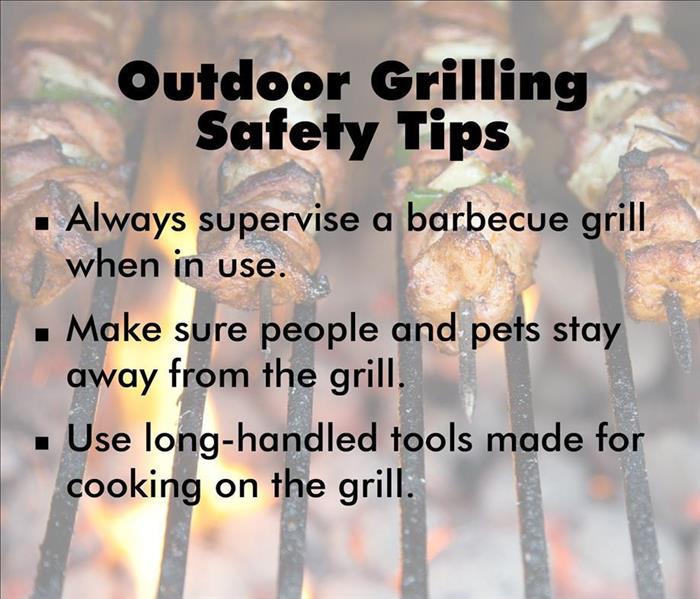 Have a fun summer and stay safe while BBQing!
Have a fun summer and stay safe while BBQing!
BBQ and Outdoor Fire Safety Tips See our BBQ Safety Tips Video! https://vimeo.com/565801174 Follow These Grilling Safety Tips:
- Only use your grill outside.
- Keep it at least 3 feet from siding, deck rails ,and eaves.
- Keep a 3 foot zone around your grill to protect kids and pets.
- Never leave fires unattended, including: grills, fire pits, and patio torches.
- Clean your girl after each use. This will remove grease that can start a fire.
Some additional tips to consider:
- Keep a fire extinguisher close. Keep a fire extinguisher within arm’s reach of the grill so you have something to put out an accidental fire. It doesn’t take long for a fire to catch and spread. Educate yourself on how to use the extinguisher beforehand.
- Do NOT decorate your grill or the area around it. Decorating for a family picnic or gathering is a great way to get into the spirit of the party, but don’t include your grill or fire pit as part of the decoration area. Flags, umbrellas, hanging decorations and baskets, and other flammable items can just become quick fuel for an out of control fire.
- Keep your grill maintained. Regular cleanings after each use are key, but the maintenance doesn’t stop there. At least one to every three months (depending on usage), you should clean your grease management system (grease trap), grates, bars, and other grilling components to reduce the chance of flare-ups and the growth of bacteria which could make you sick.
Most of all, be safe, and stay aware while around a fire. Being prepared and having a plan is always better than the alternative. Have a great summer!
Fire Damage can leave lingering odors in your Port Charlotte Home or Business
2/23/2021 (Permalink)
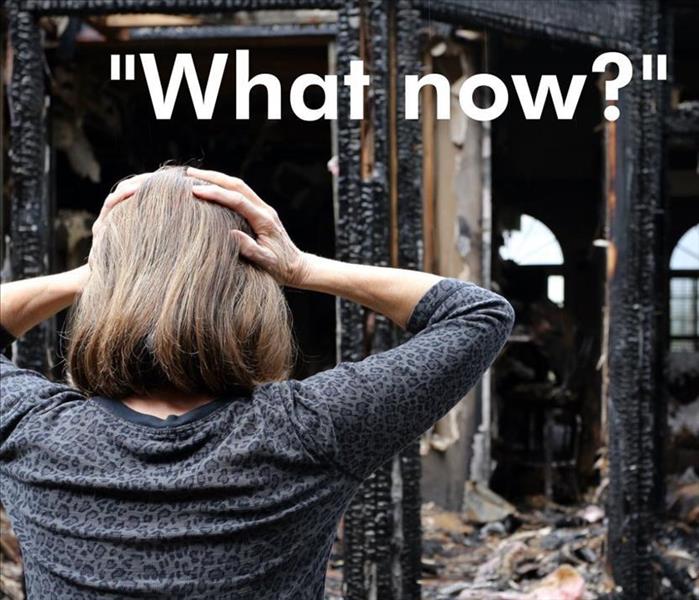 Questions after a fire damage? Call on SERVPRO of Port Charlotte
Questions after a fire damage? Call on SERVPRO of Port Charlotte
Fire damaged homes and businesses often come with variety of challenges for property owners to overcome. As overwhelming as these issues can be, there are ways that you can work to resolve some of the most pressing and challenging obstacles on your own with the right equipment, knowledge, and products. Knowing what products, information, and equipment you need for aspects like deodorization can help reduce lingering odors and damage from a fire more efficiently. Here are some "insider tips" from our SERVPRO team that we use for this niche of fire cleanup and restoration, and you can use it too to help with reducing the effects of a fire by using certain odor removal equipment.
Fire damage in Port Charlotte might feel overwhelming at first, especially with various obstacles all present at the same time. Our SERVPRO team has certified Fire & Smoke Restoration Technicians (FSRT), many with additional endorsements as Odor Control Technicians (OCT), so we have the experience and industry-leading equipment to make a difference quickly should you decide it is too much to handle on your own. Part of our success in fire recovery over the years stems from our ability to manage symptoms like lingering smoke odors amid these other effects.
Regardless of the severity of fire damage incidents, odor control is a considerable phase in recovery and restoration. Our SERVPRO team has an entire inventory of practical deodorization tools and products that lead the industry, and when combined with our extensive experience in fire recovery, improve the speed and success of these odor removal endeavors. Some of these devices we use regularly are:
- Hydroxyl Machines – These units can help to reduce or eliminate harsh odors in a compromised environment. Units also work to filter out particulates, debris, dust, and soot circulating in the damaged areas of the property.
- Thermal Foggers – While our SERVPRO professionals lean more towards UV foggers for the elimination of lingering smoke odors, thermal fogging is still a powerful tool in our arsenal. These machines are highly portable, helping to address odors throughout the entire property quickly and efficiently.
If you need our experienced SERVPRO of Port Charlotte fire restoration specialists or a second opinion on the work you have done for your home, give us a call today at 941-629-0966.
Wildfire Preparation Tips for Charlotte County
2/27/2020 (Permalink)
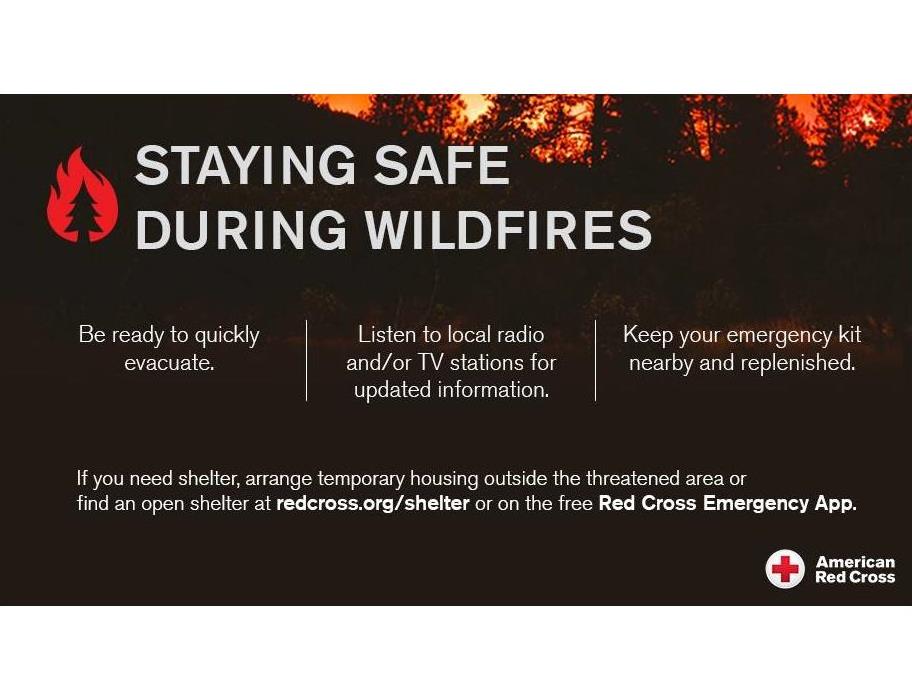 Stay Safe During Wildfires! Photo Credit: American Red Cross
Stay Safe During Wildfires! Photo Credit: American Red Cross
Wildfires! When most folks think of wildfires, they envision the massive fires that often rage in the western parts of the United States, or areas in rain forests, or Australia. While Florida is fortunate to have a rainy season, the dry season in Southwest Florida can create very arid conditions, and because our vegetation and timber are loaded with 'fuel', wildfires in Florida burn fast and hot. The recent 200+ acre wildfire in Placida and Rotunda West (February 2020) serves as a strong reminder of how close homes here in Charlotte County can be affected by a fast moving wildfire.
Following are some tips from the National Fire Protection Agency on how to best prepare before, during, and after a wildfire threatens our community.
Before a wildfire threatens your area…
In and around your home
- Clear leaves and other debris from gutters, eaves, porches and decks. This prevents embers from igniting your home.
- Remove dead vegetation and other items from under your deck or porch, and within 10 feet of the house. Learn more about the basics of defensible space on the Firewise website.
- Screen or box-in areas below patios and decks with wire mesh to prevent debris and combustible materials from accumulating.
- Remove flammable materials (firewood stacks, propane tanks) within 30 feet of your home’s foundation and outbuildings, including garages and sheds. If it can catch fire, don’t let it touch your house, deck or porch.
- Wildfire can spread to tree tops. Prune trees so the lowest branches are 6 to 10 feet from the ground.
- Keep your lawn hydrated and maintained. If it is brown, cut it down to reduce fire intensity. Dry grass and shrubs are fuel for wildfire.
- Don’t let debris and lawn cuttings linger. Dispose of these items quickly to reduce fuel for fire.
- Inspect shingles or roof tiles. Replace or repair those that are loose or missing to prevent ember penetration.
- Cover exterior attic vents with metal wire mesh no larger than 1/8 inch to prevent sparks from entering the home.
- Enclose under-eave and soffit vents or screens with metal mesh to prevent ember entry.
- Learn more about how to protect your home and property at www.firewise.org.
Creating an emergency plan
- Assemble an emergency supply kit and place it in a safe spot. Remember to include important documents, medications and personal identification.
- Develop an emergency evacuation plan and practice it with everyone in your home.
- Plan two ways out of your neighborhood and designate a meeting place.
- Learn more about emergency preparedness planning on NFPA’s emergency planning webpage.
In your community:
- Contact your local planning/zoning office to find out if your home is in a high wildfire risk area, and if there are specific local or county ordinances you should be following.
- If you are part of a homeowner association, work with them to identify regulations that incorporate proven preparedness landscaping, home design and building material use.
- Talk to your local fire department about how to prepare, when to evacuate, and the response you and your neighbors can expect in the event of a wildfire.
- Learn about wildfire risk reduction efforts, including how land management agencies use prescribed fire to manage local landscapes.
- Learn how you can make a positive difference in your community.
Read more at the following link: Wildfire preparedness tips
Keep Your Family Safe! Fire Safety Tips For Your Home
10/11/2019 (Permalink)
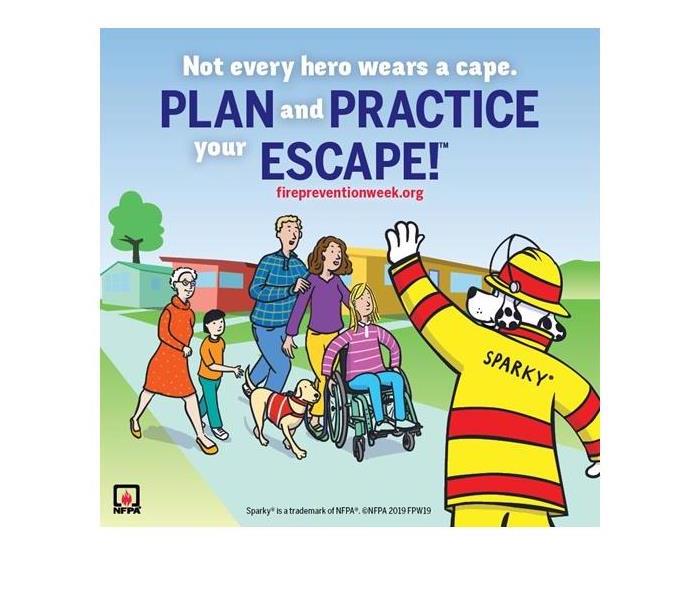 Not Every Here Wears A Cape!
Not Every Here Wears A Cape!
October is 'National Fire Prevention Month' and the week of October 6 - 12 is Fire Prevention Week. This is a time of year to remember to check our fire alarms, make sure we have debris cleared from our gutters, roof, and yard, and to update our fire escape plan if needed. It is always best to review your emergency kit at least once a year. While we recommend doing that review prior to hurricane season, many of our are residents are only here for the 'winter season', so when you arrive, make sure you make a plan to stay alive!
Following are some tips from the National Fire Protection Association (NFPA) to help you, your family, your home, and your business stay safe and prepared in case of a fire, and how to prevent one!
Why home escape planning and practice matter
- Home escape planning and practice ensure that everyone knows what to do in a fire and is prepared to escape quickly and safely.
- Today’s homes burn faster than ever. You may have as little as two minutes to escape safely from the time the smoke alarm sounds.
- When the smoke alarm sounds in a real fire, it’s too late to start making a plan.
Make a plan by clicking the following link: https://www.nfpa.org/-/media/Files/FPW/Educate/2019/FPW19LandingPageGrid.ashx
October is Fire Prevention Month
10/9/2017 (Permalink)
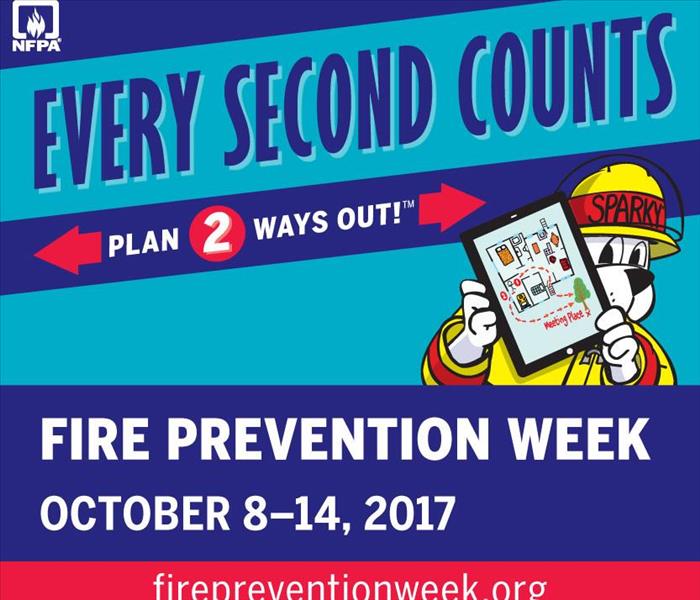 Seconds count and can mean the difference between residents of our community escaping safely from a fire or having their lives end in tragedy.
Seconds count and can mean the difference between residents of our community escaping safely from a fire or having their lives end in tragedy.
October is Fire Prevention Month and an excellent time to examine the emergency preparedness plans for your home and business, including your fire escape plan. Do you have a fire escape plan? Have you changed your smoke alarm batteries within the last year? Are you prepared?
The National Fire Protection Association (NFPA) sets aside a designated week each October to focus on fire prevention. The 2017 theme is “Every Second Counts: Plan 2 Ways Out!”
According to the NFPA, once the fire alarm goes off “you could have less than two minutes to get out safely,” yet only 8 percent of people surveyed said getting out was the first thought after hearing a fire alarm. Creating, implementing, and practicing a fire escape plan for your home or business may be the difference between safety and tragedy. Make a plan today.
Refer to the following link for more information about how to implement your fire escape plan for both your home, Red Cross Fire Escape Planning and your business: OSHA - Evacuation Plans and Procedures eTool
SERVPRO® of Port Charlotte wants you to stay safe, informed, and prepared to help ensure you are ready for any disaster that comes your way.
Port Charlotte Smoke and Soot Cleanup
6/9/2017 (Permalink)
 Smoke and Soot Damage Can Cause a Pervasive Odor in Your Port Charlotte Home.
Smoke and Soot Damage Can Cause a Pervasive Odor in Your Port Charlotte Home.
Smoke and soot is very invasive and can penetrate various cavities within your home, causing hidden damage and odor. Our smoke damage expertise and experience allows us to inspect and accurately assess the extent of the damage to develop a comprehensive plan of action.
Smoke and soot facts:
- Hot smoke migrates to cooler areas and upper levels of a structure.
- Smoke flows around plumbing systems, seeping through the holes used by pipes to go from floor to floor.
- The type of smoke may greatly affect the restoration process.
Different Types of Smoke
There are two different types of smoke–wet and dry. As a result, there are different types of soot residue after a fire. Before restoration begins, SERVPRO of Port Charlotte will test the soot to determine which type of smoke damage occurred. The cleaning procedures will then be based on the information identified during pretesting. Here is some additional information:
Wet Smoke – Plastic and Rubber
- Low heat, smoldering, pungent odor, sticky, smeary. Smoke webs are more difficult to clean.
Dry Smoke – Paper and Wood
- Fast burning, high temperatures, heat rises therefore smoke rises.
Protein Fire Residue – Produced by evaporation of material rather than from a fire
- Virtually invisible, discolors paints and varnishes, extreme pungent odor.
Our Fire Damage Restoration Services
Since each smoke and fire damage situation is a little different, each one requires a unique solution tailored for the specific conditions. We have the equipment, expertise, and experience to restore your fire and smoke damage. We will also treat your family with empathy and respect and your property with care.
Have Questions about Fire, Smoke, or Soot Damage?
Call Us Today – (941) 629-0966
 After the fire department leaves, call SERVPRO of Port Charlotte to help restore your home or business.
After the fire department leaves, call SERVPRO of Port Charlotte to help restore your home or business.






 24/7 Emergency Service
24/7 Emergency Service






